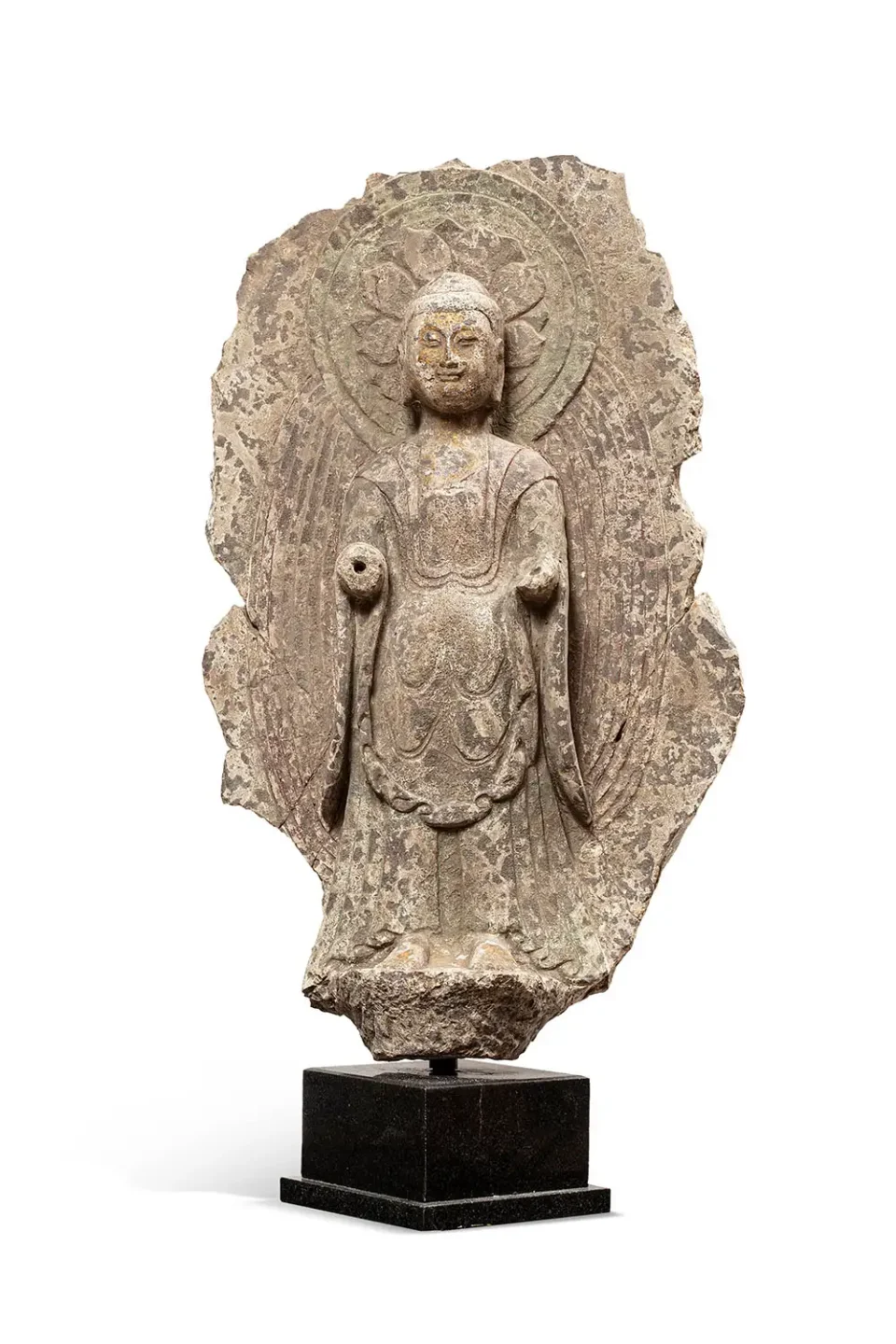Stone estimate
Do you own a work of art or an object in Asian hard stone and would like to appraise it?
Our auctioneers and experts specializing in Asian art appraise your works of art free of charge and help you sell them at auction.
Receive a confidential estimate for your Asian hardstone works and objects within 48 hours.
Chinese hard stones, notably jade, jadeite, coral and carnelian, have seen their value soar in recent years. This trend is particularly marked for jade pieces, which represent an important cultural and spiritual symbol in China. Hard stones are used to create a variety of objects, from sculptures to jewelry, and continue to be prized for both their beauty and their historical significance.
Getting an accurate estimate of your piece’s value is essential in a booming market.
Estimate and price of stone works
The Asian hardstone market is very active today, with prices ranging from a few hundred to several million euros. Jade sculptures, particularly those from the Qing dynasty, are among the most sought-after, as are finely chiselled jadeite pieces. Beware, exceptional records can be set!
Price table for Asian hard stones
| Object type | Period | Price range | Auction examples and results |
|---|---|---|---|
| Sculptures in jade | 19th – 20th centuries | 1 000 € – 30 000 000 € | Jadeite sculpture of a cabbage, sold for 18 million euros. |
| Carnelian vases | Nineteenth century | 100 € – 73 000 € | Carnelian and chalcedony brush pot, Qianlong period, €73,000. |
| Objects in agate | Nineteenth century | 900 € – 10 000 € | Carved agate snuffbox, sold for 900 euros. |
| Lapis lazuli objects | Twentieth century | 500 € – 2 500 € | Lapis lazuli set, sold for 500 euros. |
These values can fluctuate according to a number of factors, such as condition, rarity and provenance. Older pieces in good condition are highly prized, but modern or contemporary works bearing the signature of a recognized artist can also fetch significant prices.
Why should I have my hardstone work appraised?
Asium offers you a free appraisal of your works, whatever your needs.
- For insurance purposes, before any accident or damage.
- In the event of an inheritance, you may need a reliable estimate for inheritance tax purposes.
- In the event of a division or divorce, our valuation ensures that no party is prejudiced.
- Out of curiosity, to find out the value of your object.
How can I get an estimate for my hard stone with Asium?
You can request an estimate online via our form, where you can submit photos and descriptions of your works.
How to recognize a hard stone and value it
To evaluate a genuine hard stone, it is essential to consider several elements:
Techniques and materials
- Surface: A good quality hard stone should have a smooth, shiny finish, often achieved by polishing. For example, well-polished jade will have a deep lustre with no visible flaws.
- Color: Colors should be rich and uniform. For jade, shades of green, white and lavender are highly prized. Color variations or stains can reduce value.
- Patterns: Motifs should be finely sculpted. For example, well-defined floral or animal motifs on a sculpture increase its value. Conversely, blurred or poorly executed motifs can diminish its appeal.
- Condition: The overall condition of the piece is crucial. A sculpture with chips or cracks could see its value drop by 50% or more. For example, an intact jade statue could be worth 100,000 euros, while a similar damaged one would only be worth 20,000 euros.
Signs of authenticity
- Craftsman’s marks: Renowned craftsmen often leave their mark or signature on their work, increasing its value. For example, a piece signed by a master craftsman of the Qing dynasty could be worth much more than an anonymous piece.
- Certificates of authenticity: Obtaining a certificate of authenticity at the time of purchase is highly recommended. This can guarantee the provenance and quality of the object, thus increasing its market value.
Signatures: what impact on the estimate?
The signature of the craftsman or workshop is essential in assessing the value of a hard stone object. For example, a jade sculpture signed by a renowned master can fetch record prices. A piece signed by a craftsman from the Ming dynasty, known for its refined techniques, could be estimated at 100,000 euros or more.

Condition and provenance: the pluses and minuses of valuation
The state of preservation
The overall condition of a piece, including the presence of cracks, retouching or repairs, directly influences its price. For example, a jade vase in perfect condition could fetch 500,000 euros, while a similar vase with defects could be worth as little as 50,000 euros.
Provenance
A prestigious provenance considerably increases the work’s appeal. A jade sculpture that belonged to an imperial collection could see its value triple, potentially reaching 1.5 million euros. A documented provenance, such as a certificate of origin or sales history, can also positively influence the estimate.
A brief history of Asian hard stones
The history of hard stones in Asia goes back thousands of years. In China, for example, the use of jade dates back to the Shang dynasty (1600-1046 BC), when it was mainly used for ritual objects. Over the course of the dynasties, the art of stone-cutting evolved into a truly refined art.
- Shang Dynasty: Beginning of the use of jade for ritual objects, reflecting beliefs in its protective qualities.
- Han Dynasty: Emergence of jade burial suits, marking an advance in craftsmanship and culture.
- Tang Dynasty: Popularization of coral and carnelian, with sculpted pieces prized for their intricate designs.
- Ming Dynasty: Introduction of jadeite, a rarer and more precious variety, whose sculptures are much sought-after.
- Qing Dynasty: Period of production of exceptional works in hard stone, with strong demand on today’s market.

The evolution of hard stones in Asia reflects not only centuries of craft tradition, but also the influence of global artistic trends. Today, ancient and contemporary pieces continue to captivate art lovers, as much for their technique as for the cultural heritage they convey. Today’s market is seeing a growing interest in these works, rediscovering a timeless heritage.
Our experts in stone
-

Eunbi HA
-

TaHsi CHANG
Specialist in the arts of VIETNAM and CHINA
Our areas of expertise
Your questions, our answers
How do I know whether my hardstone object was made in Asia or elsewhere?
There are stylistic and technical clues that enable us to attribute a geographical origin. For example, Asian jade is distinguished by its cutting style: Chinese and Japanese craftsmen used particular tools and polishing methods, sometimes absent from Western works. Engraved motifs, such as dragons or lotus flowers, and the use of forms specific to each culture (such as belt plates or amulets), are also key elements in identifying an Asian origin. An expert’s trained eye can help confirm this provenance.
My object looks old but is worn. Does this affect its value much?
The value of Asian hard stones can sometimes remain high even with signs of wear, especially if these signs are natural and stem from ritual use or a particular history. On the other hand, chips, cracks or clumsy repairs can lower the estimate, unless the object has a rarity or prestigious provenance, such as an ancient imperial collection. Wear can sometimes tell the story of an object, and an expert will be able to determine the extent to which it affects value.
Is my object more precious if the stone is of rare origin, such as imperial jade?
Yes, certain stones such as imperial jade, antique turquoise or engraved rock crystal are particularly sought-after, especially if they are of high quality. Imperial jade, for example, is a variety of jadeite prized for its intense green color and translucency. Objects carved from rare or exceptional stones, especially if they date from important historical periods such as the Ming or Qing dynasties, can fetch much higher values.
The Asium estimation service is...

Simple
and free
A few photos of your work, a few words of description and you're all set !

Fast
but not too fast
Our experts are serious, they take the time to research and get back to you within a week.

Reliable
and confidential
Our auctioneers are the Sherlock Holmes of the art market.































